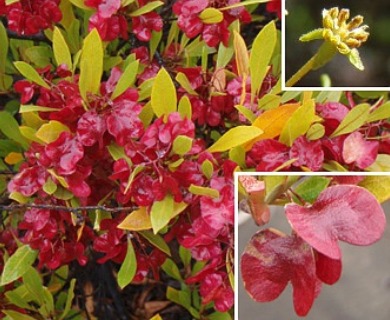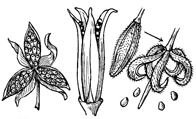ʻAʻaliʻi
Dodonaea viscosa
Maple family (Sapindaceae)
Native species (indigenous)
Native much-branched shrub or small tree with sticky yellow green leaves and rounded dry with three or four papery wings, in the broad sense, here regarded as one variable species through the Hawaiian Islands and beyond. Sometimes a small tree up to 30 ft (9 ) and 3 inches (7.5 ) in trunk diameter, with a rounded Bark dark brown, finely fissured. Twigs slender, slightly angled, light brown, hairless.

©2012 Eric White
Flower clusters () at ends of twigs, about 1 inch (2.5 ) long, finely hairy, sticky. Flowers partly male, female, and on the same plant or different plants (polygamous), about 1⁄4 inch (6 ) long, with 5 hairy and no petals. Male flowers have 10 Female flowers have with short and four dot stigmas.
() swollen, dry, rounded, 3⁄8–5⁄8 inch (1–1.5 ) long, notched at both ends, with three or four, sometimes two, papery round wings, of colors ranging from yellow green to pink to brown to dark maroon, spreading up to 3⁄4 inch (2 ) across, finely hairy on edges, sometimes viscous or sticky, 3–4-celled. Seeds 4–1, elliptical, blackish, 1⁄8 inch (3 ) long.
The wood is yellow brown and the small heartwood is black when present. It is very hard and heavy and said to be durable. It was sometimes used for house posts and spears.
The leaves were used by the Hawaiians for medical purposes. Like hops, the flowers were served to impart a bitter flavor, and also were used as a tonic. The attractively colored is also used in leis for the hair. A red dye was made from the capsules.
Found throughout the Hawaiian Islands, including Niihau, especially in dry regions at about 10–7700 ft (3–2347 ) altitude. Most easily seen in the national parks on Hawaii and Maui and the Waimea Canyon area of Kauai. The tallest specimens, about 30 ft (9 ) high, are along the Mauna Loa Strip Road in Hawaii Volcanoes National Park. The tree-sized plants are mostly in the upper elevation forests of Hawaii and Maui, but are also observed occasionally in Waianae and Koolau Ranges on Oahu.
Special areas
Haleakala, Volcanoes
Range
Widespread through tropics of both hemispheres, including Puerto Rico and Virgin Islands, Florida, and Arizona.
Other common names
‘a‘ali‘i-ku ma kua, ‘a‘ali‘i ku makani; lampuaye (Guam); mesechelangel (Palau)
Botanical
Dodonaea eriocarpa Sm., D. sandwicensis Sherff, D. stenocarpa Hillebr.
Three other species with many named varieties and forms recorded from Hawaii are united here under a single very variable species.
This species and wingleaf soapberry or manele, Sapindus saponaria, are the only tree species native in both Hawaii and continental United States.







